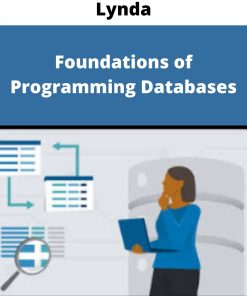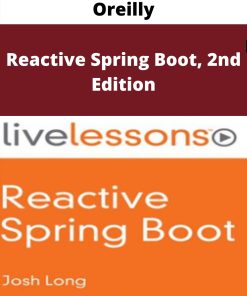Udemy – Web Development W/ Google?s Go (Golang) Programming Language
$64.00 Original price was: $64.00.$7.00Current price is: $7.00.
Udemy – Web Development W/ Google’s Go (Golang) Programming Language – Available Now !!!
Sale Page : udemy.com
Value: 64
You just pay: 7
Status: This item is available
Description:
What you’ll learn
- Construct server-side applications using today’s best practices
-
Acquire an outstanding foundation in the fundamentals of web programming
-
Learn from a University Professor in Computer Science with over 15 years of experience teaching individuals of all ability levels
- Achieve mastery in the understanding and application of web development
- Understand servers, routing, restful applications, JSON, AJAX, templates, file servers, cookies, state, UUIDs, HTTP methods, HTTP response codes, sessions, Amazon Web Services, MySQL, MongoDB, load balancers, HTTPS & TLS, Docker, Containers, Virtual Machines, Google Cloud, and App Engine
- Create web applications using only the Go programming language’s standard library
- Create web applications without using third-party frameworks
- Build performant distributed applications that dynamically scale
- Apply cutting-edge web development practices
Requirements
- You must understand how to program with the Go programming language before taking this course. If you do not know how to program with Go, please take my course: “Learn How To Code: Google’s Go (golang) Programming Language”
Description
The Go programming language was created by Google to do what Google does: performant web applications at scale.
Open-sourced in 2009 and reaching version one in 2012, the Go programming language is the best choice for web development programming today.
Ruby on Rails, Python, Django, Node.js, PHP, and ASP all fall short.
Go is the most powerful, performant, and scalable programming language today for creating web applications, web API’s, microservices, and other distributed services.
In this course, you will gain a solid foundation in web development. You will learn all of the following and more:
Architecture
- networking architecture
- the client / server architecture
- the request / response pattern
- the RFC standards defined by the IETF
- the format of requests from clients and responses from servers
Templates
- the role that templates play in server-side programming
- how to work with templates from Go’s standard library
- modifying data structures to work well with templates
Servers
- the relationship between TCP and HTTP
- how to create a TCP server which acts as an in-memory database
- how to create a restful TCP server that handles various routes and methods
- the difference between a web server, a servemux, a multiplexer, and a mux
- how to use a third-party server such as julien schmidt’s router
- the importance of HTTP methods and status codes
The net/http package
- streamlining your web development with the net/http package
- the nuances of the net/http package
- the handler interface
- http.ListenAndServe
- creating your own servemux
- using the default servemux
- http.Handle & http.Handler
- http.Handlefunc, func(ResponseWriter, *Request), & http.HandlerFunc
- http.ServeContent, http.ServeFile, & http.FileServer
- http.StripPrefix
- http.NotFoundHandler
State & Sessions
- how to create sessions: login, permissions, logout
- how to expire a session
Deployment
- how to purchase a domain
- how to deploy an application to Google Cloud
Amazon Web Services
- how to use Amazon Web Services (AWS)
- how to create a virtual linux machine on AWS EC2 (Elastic Cloud Compute)
- what load balancers are and how to use them on AWS
MySQL
- how to use MySQL on AWS
- how to connect a MySQL workbench to AWS
MongoDB
- understanding CRUD
- how to use MongoDB & Go
MVC (Model View Controller) Design Pattern
- understanding the MVC design pattern
- using the MVC design pattern
Docker
- virtual machines vs containers
- understanding the benefits of using Docker
- Docker images, Docker containers, and Docker registries
- implementing Docker and Go
- deploying Docker and Go
Google Cloud
- Cloud memcache
- Cloud PAAS App Engine
Web Dev Toolkit
- AJAX
- JSON
- json.Marhsal & json.Unmarshal
- json.Encode & json.Decode
- Hash message authentication code (HMAC)
- Base64 encoding
- Web storage
- Context
- TLS & HTTPS
- JSON with Go using Tags
Building Applications
- a photo blog
- a twitter clone
By the end of this course, you will have mastered the fundamentals of web development.
My name is Todd McLeod. I am tenured faculty in Computer Information Technology at Fresno City College and adjunct faculty in Computer Science at California State University Fresno. I have taught enough students over 17 years to know that by the end of this course, you will be an outstanding web developer.
You will have the hottest, most demanded, and highest paid skills in the marketplace.
Join me in this outstanding course. Come learn best practices for web development. Sign up for this course now and open doors to a great future.
Who this course is for:
- This course is perfect for programmers wanting a thorough introduction to web development using the Go programming language.
- This course is perfect for developers wanting to fill in gaps in their knowledge.
Please kindly contact us if you need proof of item.
Find out more IT Technologies Courses >>> At Here !!!
1 review for Udemy – Web Development W/ Google?s Go (Golang) Programming Language
Add a review Cancel reply
Related products
IT & Technology
IT & Technology
Springer – Programming Heterogeneous Mpsocs: Tool Flows To Close The Software Productivity Gap
IT & Technology
IT & Technology
Udemy – 50 Tools For The Ultimate Accelerated Learning Office
IT & Technology
IT & Technology
Pluralsight – Creating Security Baselines in Microsoft Azure
IT & Technology
IT & Technology












Brianna Avery –
Thank you very much! | Udemy – Web Development W/ Google?s Go (Golang) Programming Language